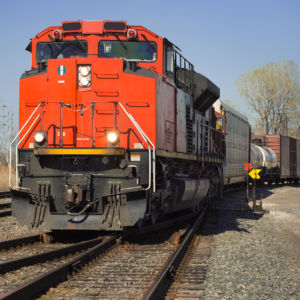America’s rail industry has a message for Washington, D.C.: It’s time to get rid of regulations from the last century so rail can roll forward into the next.
Noting the 40th anniversary of the law that deregulated freight rail shipping, a panel of economists and former government officials voiced support for updating the outdated Staggers Act, which was signed into law on Oct. 14, 1980.
“It’s done its job,” said Wesley Wilson, an economist from the University of Oregon. “Let’s move on. Let’s modernize.” Wilson sat on the National Academy of Sciences Committee for Study of Freight Rail Regulation, which published a report in 2015 calling for a better way to measure railroads’ operating funds and ensure they have adequate revenue streams.
But Clifford Winston, an economist with the Brookings Institute, went further, calling for an end to the Surface Transportation Board, an independent federal board with economic oversight of railroads. The board was created in 1996 to replace the Interstate Commerce Commission.
“What do we need the Surface Transportation Board for?” Winston said. “It’s been four decades of huge inefficiencies and is more of a testament that it’s extremely difficult to get government out of industries it regulated in the past.”
The two economists made their comments during a panel hosted by the Regulatory Studies Center at George Washington University called “Delivering the Goods: 40 Years of Surface Freight Deregulation.”
Other panelists included Darius Gaskin, a former chairman of the Interstate Commerce Commission; Craig Keats, general counsel for the Surface Transportation Board; and Dorothy Robyn, a non-resident senior fellow at the Institute for Sustainable Energy and a former White House National Economic Council staffer in the Clinton administration.
The live webinar followed two pre-recorded panels on “How Regulatory Reform Happened” and “Results of Regulatory Reform.”
Before the Staggers Act, the country’s railroads were heavily regulated with mechanisms that included price controls. Post-Staggers Act, railroads could negotiate with shippers, end unprofitable service and even abandon certain lines. Wilson noted that there’s been a “greater decline in costs” that has contributed to the industry’s success.
The rail industry’s viability faces a future that will contain autonomous trucks with capacities that could rival trains — a major point of contention.
It sparked an exchange between Winston and James Peoples, an economist with the University of Wisconsin-Milwaukee and former president of the Transportation and Public Utilities Group of the Allied Social Services Association. The question of truck vs. train for shippers will become even more contentious if the trucking industry succeeds in creating separate “truck-only” highways.
“They’re ahead of autonomous cars in development,” Winston said. “They can run all night with huge capacity. They could be formidable.”
Separate from the panel, an industry group called GoRail sent a letter to the Surface Transportation Board asking it to “preserve the delicate regulatory balance created by the Staggers Act.”
“Since the implementation of a balanced system of economic regulation under the Staggers Act, which protects rail customers while allowing railroads to manage their assets and pricing, U.S. freight railroads have invested hundreds of billions of dollars in the rail network. Rail traffic has doubled, rail productivity has more than doubled, rail rates are down more than 40 percent, and recent years have been the safest on record,” read the letter, which was signed by more than 1,000 national and local leaders in 46 states.
The Association of American Railroads similarly lauded the Staggers Act in a statement.
“Today’s nimble, resilient rail network is built upon the rock-solid foundation laid 40 years ago with the signing of the Staggers Act,” said association president and CEO Ian Jefferies. “In the face of a dynamic competitive landscape, the smart regulatory framework, which predominantly relies on market forces to govern rail rates, still empowers railroads to invest, innovate and deliver for customers and communities every day. Staggers has stood the test of time and remains just as relevant and essential in 2020 as it was in 1980.”
Research from the American Consumer Institute found that deregulation has resulted in a 44 percent reduction in transportation prices and yields $10 billion of annual consumer benefits.
“It is as important now as ever for railroads, shippers and customers alike that policymakers defer to the market as much as possible to avoid heavy-handed regulation that nearly cost the U.S. a viable freight rail industry,” institute president Steve Pociask said.

